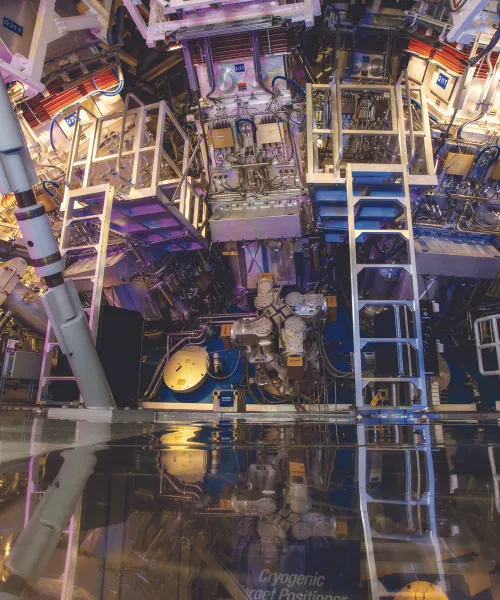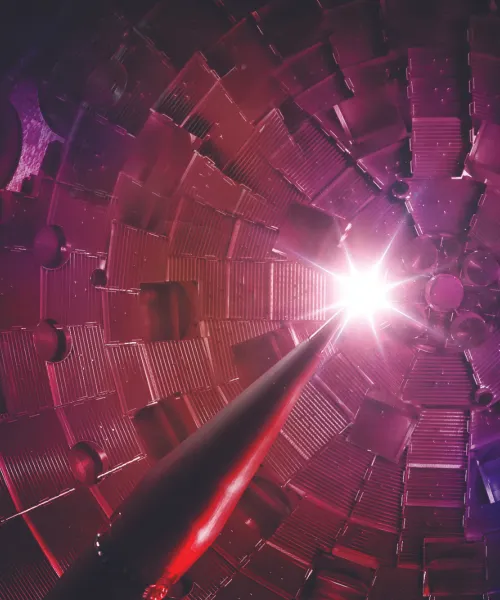By Jeremy Thomas, Lawrence Livermore National Laboratory, Dr. Bruce Remington '75 BS and Rebecca Tavernini '11 MA
Just after 1 a.m. on Monday, December 5, 2022, a little east of San Francisco, the future changed for the better.
At Lawrence Livermore National Laboratory (LLNL), scientists produced more energy from a self-sustaining fusion reaction than the laser power needed to create the reaction: a condition known as ignition. They created a potentially world-changing breakthrough for fusion energy—the same reaction that powers the sun and the stars—and a key step in a decades-long quest for limitless clean energy.
U.S. Department of Energy Secretary Jennifer Granholm called it “one of the most impressive scientific feats of the 21st century,” on par with the Wright brothers’ first flight at Kitty Hawk.
Bruce Remington ’75 BS, a physicist who heads the Discovery Science program at the National Ignition Facility (NIF), where the ignition experiments are performed, played an early role in this breakthrough. Beginning in 1988, Remington worked on Inertial Confinement Fusion (ICF) techniques using the world’s most energetic lasers, studying hydrodynamic instabilities and mix as a staff physicist, before shifting his focus to high energy density (HED) science. In 2014, he took over the NIF Discovery Science program, a competitive program that allows scientists both inside and outside LLNL to use NIF for basic science experiments.
Best known for his work in HED laboratory astrophysics, Remington was awarded the American Physical Society’s John Dawson Award in 2022 for his pioneering work in laser- driven, high-pressure experiments. In 2023, he won the George E. Duvall Shock Compression Science Award for pioneering laser-driven high-pressure, solid-state material dynamics experiments in high-energy density regimes, like those encountered at the center of giant planets or brown dwarfs. He also won the 2001 Edward Teller Medal at LLNL for pioneering research and leadership in inertial fusion sciences.
For the history-making ignition shot last December, NIF scientists performed a NIF shot as they always do — firing the facility’s 192 powerful lasers onto a BB-sized target of deuterium and tritium, heavier isotopes of hydrogen. However, in this experiment, the laser energy was upped to 2.05 megajoules (MJ), and conditions of implosion symmetry, heat and compression were just right.
For the history-making ignition shot last December, NIF scientists performed a NIF shot as they always do — firing the facility’s 192 powerful lasers onto a BB-sized target of deuterium and tritium, heavier isotopes of hydrogen. However, in this experiment, the laser energy was upped to 2.05 megajoules (MJ), and conditions of implosion symmetry, heat and compression were just right.
Though the historic Wright brothers’ flight took 12 seconds, it was just a fraction of a second at LLNL when researchers produced 3.15 MJ of fusion energy output using 2.05 MJ of laser energy delivered to the target, demonstrating the fundamental science basis for inertial fusion energy.

“I was very relieved when we reached ignition,” Remington said. “We initially proposed a 2.4 MJ, 240-beam laser for NIF. It was felt by people better connected to the realities of getting new big projects funded, that we needed to drop the original NIF design to be 192 beams, for a total energy of 1.8 MJ. The unsung heroes in this story are the NIF laser scientists. Since NIF was built and turned on, they have been quietly, yet persistently, turning a 1.8 MJ laser into a 2.05 MJ laser, which was the energy they used for the first ignition shot on NIF.”
The achievement was the culmination of 60 years of exploration and experimentation, with collaborators in industry, academia and national labs such as Los Alamos and Sandia. Clean-energy power plants are the next end goal.
“The next steps are to find ways to increase the energy output to reach high gain regimes, and to develop new techniques and capabilities to be able to do these types of experiments multiple times per second, as opposed to a few times per day currently,” Remington said. “Each would be a monumental step forward.”
The results will also enable scientists to conduct nuclear science at stellar core conditions, as well as doing nuclear burn experiments relevant to the U.S. National Nuclear Security Administration’s science-based Stockpile Stewardship Program.
The breakthrough moment was not lost on LLNL employees, like Remington, as they were lauded for pushing the boundaries of science and the movement toward renewable energy.
Remington, who initially came to Northern Michigan University on a scholarship to play football, said he realized he wanted to study physics more seriously, and reluctantly quit football to focus his efforts solely on science.
“The professors at NMU never gave up on me,” Remington said. “Fred Trentelman (physics), and Bob Myers (math) were both very influential in helping me try to get my feet on the ground and get some traction.” Remington received the NMU Distinguished Alumni Award in 2014.
After spending some time teaching physics in Turkey, he returned to the U.S. and earned his Ph.D. in physics from Michigan State University in 1986, conducting his research at the National Superconducting Cyclotron Laboratory on MSU’s campus. He moved on to LLNL for a two-year postdoctoral appointment, performing heavy- ion, nuclear reaction experiments and simulations. He entered LLNL’s ICF program in 1988 as a staff physicist, conducting experiments on the Lab’s Nova laser system, which was the world’s largest laser at that time.
In addition to his ICF work, Remington pioneered the use of high-energy lasers to study Rayleigh-Taylor driven plastic flows at high pressures, strains and strain rates. He is author or coauthor on more than 400 publications and is a recipient of the Dawson award for his work on ablation-front Rayleigh-Taylor flow instabilities.

